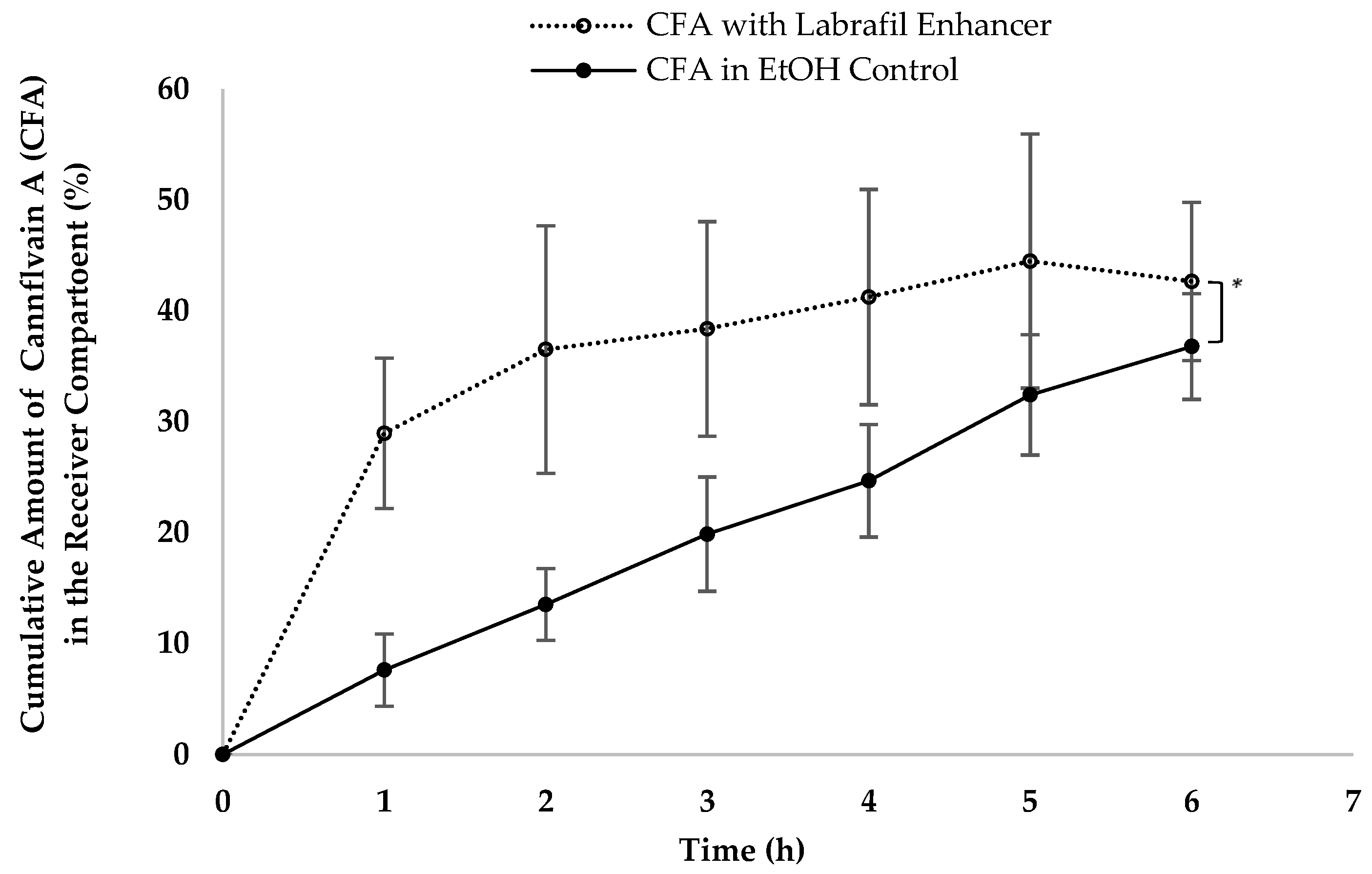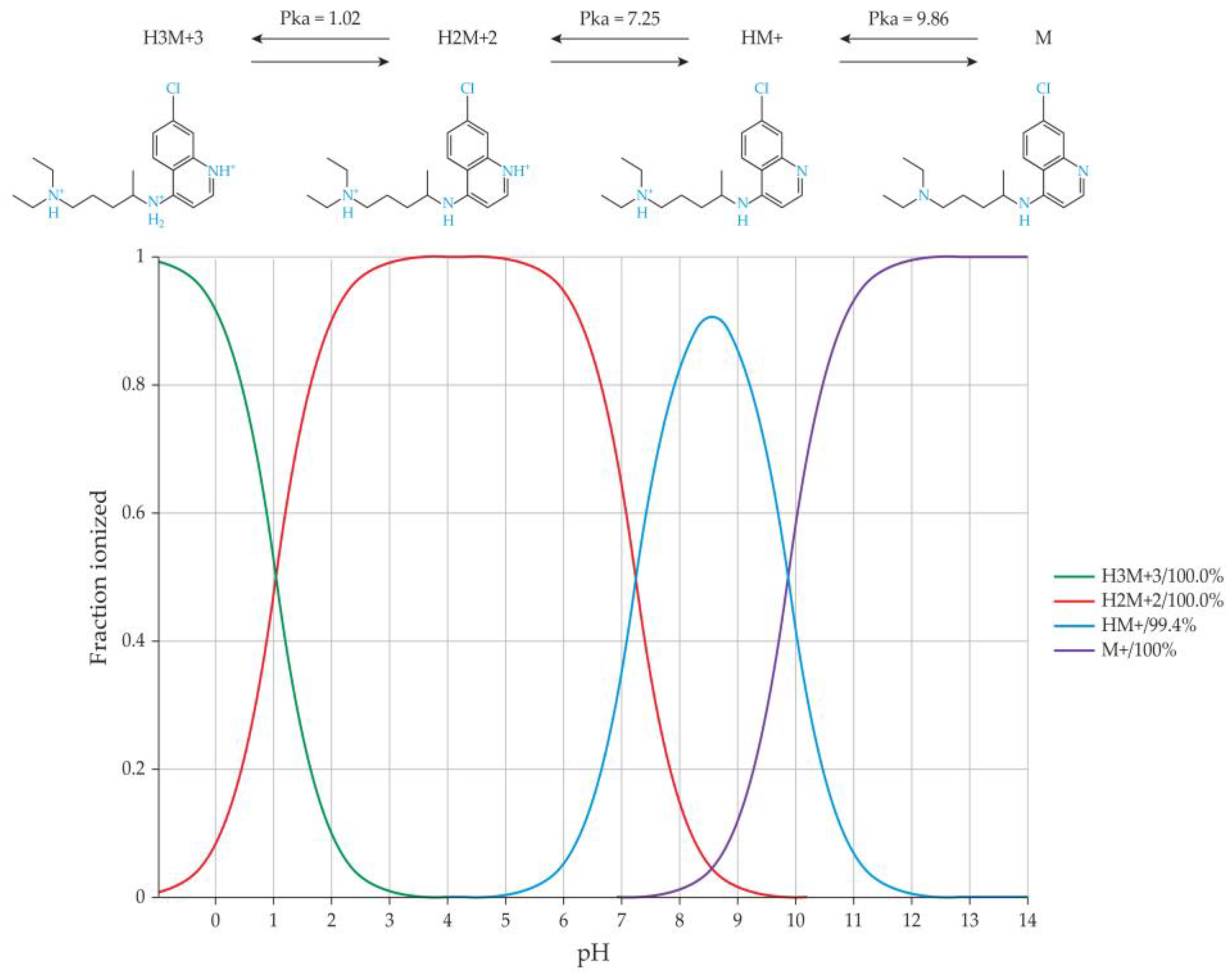In Vitro Predictive Model for Intestinal Lymphatic Uptake: Exploration of Additional Enhancers and Inhibitors
Abstract
:1. Introduction
2. Materials and Methods
2.1. Materials
2.2. Methods
2.2.1. Franz Cell for Studying Intestinal Lymphatic Uptake
2.2.2. Measurement of Zeta Potential of Intralipid®
2.2.3. Statistical Analysis
3. Results and Discussion
3.1. Effects of Different Oils Augmenting In Vitro Intestinal Lymphatic Uptake
| Fatty Acid | Length: Saturation | % of Fatty Acid in Different Oils | |||
|---|---|---|---|---|---|
| Coconut Oil [28] | Olive Oil [37] | Sesame Oil [38] | Peanut Oil [40] | ||
| Capric Acid | C8:0 | 7 | - | - | - |
| Caprylic Acid | C10:0 | 8 | - | - | - |
| Lauric Acid | C12:0 | 49 | - | - | - |
| Myristic Acid | C14:0 | 8 | - | - | - |
| Palmitic Acid | C16:0 | 8 | 7.5–20 | 11–16 | 11–14 |
| Stearic Acid | C18:0 | 2 | 0.5–5 | 11–16 | - |
| Oleic Acid | C18:1 | 6 | 55–83 | 35–46 | 45–53 |
| Linoleic Acid | C18:2 | 2 | 3.5–21 | 40–48 | 27–32 |
| Linolenic Acid | C18:3 | - | - | 0.5 | - |
| Arachidic Acid | C20:0 | - | - | - | 1–2 |
| Behenic Acid | C22:0 | - | - | - | 1.5–4.5 |
3.2. The Effect of Changing the Zeta Potential of Artificial Chylomicrons on Lymphatic Uptake
4. Conclusions
Author Contributions
Funding
Institutional Review Board Statement
Informed Consent Statement
Data Availability Statement
Conflicts of Interest
References
- Zhang, Z.; Lu, Y.; Qi, J.; Wu, W. An Update on Oral Drug Delivery via Intestinal Lymphatic Transport. Acta Pharm. Sin. B 2021, 11, 2449–2468. [Google Scholar] [CrossRef]
- Cifarelli, V.; Eichmann, A. The Intestinal Lymphatic System: Functions and Metabolic Implications. Cell. Mol. Gastroenterol. Hepatol. 2019, 7, 503–513. [Google Scholar] [CrossRef]
- Yáñez, J.A.; Wang, S.W.; Knemeyer, I.W.; Wirth, M.A.; Alton, K.B. Intestinal Lymphatic Transport for Drug Delivery. Adv. Drug Deliv. Rev. 2011, 63, 923–942. [Google Scholar] [CrossRef]
- Wang, T.Y.; Liu, M.; Portincasa, P.; Wang, D.Q.H. New Insights into the Molecular Mechanism of Intestinal Fatty Acid Absorption. Eur. J. Clin. Investig. 2013, 43, 1203–1223. [Google Scholar] [CrossRef]
- Yousef, M.; Silva, D.; Chacra, N.B.; Davies, N.M.; Löbenberg, R. The Lymphatic System: A Sometimes-Forgotten Compartment in Pharmaceutical Sciences. J. Pharm. Pharm. Sci. 2021, 24, 533–547. [Google Scholar] [CrossRef]
- Hokkanen, K.; Tirronen, A.; Ylä-Herttuala, S. Intestinal Lymphatic Vessels and Their Role in Chylomicron Absorption and Lipid Homeostasis. Curr. Opin. Lipidol. 2019, 30, 370–376. [Google Scholar] [CrossRef] [PubMed]
- Trevaskis, N.L.; Kaminskas, L.M.; Porter, C.J. From Sewer to Saviour-Targeting the Lymphatic System to Promote Drug Exposure and Activity. Nat. Rev. Drug Discov. 2015, 14, 781–803. [Google Scholar] [CrossRef] [PubMed]
- Dahan, A.; Hoffman, A. Evaluation of a Chylomicron Flow Blocking Approach to Investigate the Intestinal Lymphatic Transport of Lipophilic Drugs. Eur. J. Pharm. Sci. 2005, 24, 381–388. [Google Scholar] [CrossRef] [PubMed]
- Yousef, M.; Park, C.; Henostroza, M.; Bou-Chacra, N.; Davies, N.M.; Löbenberg, R. Development of a Novel In Vitro Model to Study Lymphatic Uptake of Drugs via Artificial Chylomicrons. Pharmaceutics 2023, 15, 2532. [Google Scholar] [CrossRef]
- Gershkovich, P.; Hoffman, A. Uptake of Lipophilic Drugs by Plasma Derived Isolated Chylomicrons: Linear Correlation with Intestinal Lymphatic Bioavailability. Eur. J. Pharm. Pharm. Sci. 2005, 26, 394–404. [Google Scholar] [CrossRef]
- Morita, S.-y.; Kawabe, M.; Nakano, M.; Handa, T. Pluronic L81 Affects the Lipid Particle Sizes and Apolipoprotein B Conformation. Chem. Phys. Lipids. 2003, 126, 39–48. [Google Scholar] [CrossRef] [PubMed]
- Tso, P.; Balint, J.A.; Bishop, M.B.; Rodgers, J.B. Acute Inhibition of Intestinal Lipid Transport by Pluronic L-81 in the Rat. Am. J. Physiol.—Gastrointest. Liver Physiol. 1981, 241, G487–G497. [Google Scholar] [CrossRef] [PubMed]
- Fatma, S.; Yakubov, R.; Anwar, K.; Hussain, M.M. Pluronic L81 Enhances Triacylglycerol Accumulation in the Cytosol and Inhibits Chylomicron Secretion. J. Lipid Res. 2006, 47, 2422–2432. [Google Scholar] [CrossRef] [PubMed]
- Yousef, M.; Park, C.; Le, T.S.; Chacra, N.B.; Davies, N.M.; Löbenberg, R. Simulated Lymphatic Fluid for In-Vitro Assessment in Pharmaceutical Development. Dissolution Technol. 2022, 29, 86–93. [Google Scholar] [CrossRef]
- Feng, W.; Qin, C.; Abdelrazig, S.; Bai, Z.; Raji, M.; Darwish, R.; Chu, Y.J.; Ji, L.; Gray, D.; Stocks, M.J.; et al. Vegetable Oils Composition Affects the Intestinal Lymphatic Transport and Systemic Bioavailability of Co-administered Lipophilic Drug Cannabidiol. Int. J. Pharm. 2022, 624, 121947. [Google Scholar] [CrossRef] [PubMed]
- Grifoni, L.; Vanti, G.; Bilia, A.R. Nanostructured Lipid Carriers Loaded with Cannabidiol Enhance Its Bioaccessibility to the Small Intestine. Nutraceuticals 2023, 3, 210–221. [Google Scholar] [CrossRef]
- Ndifor, A.M. Drug Metabolism in Malaria Parasites and Its Possible Role in Drug Resistance. Ph.D. Thesis, The University of Liverpool, Liverpool, UK, 1992. [Google Scholar]
- Rowe, R.C.; Sheskey, P.J.; Owen, S.C. Handbook of Pharmaceutical Excipients, 5th ed.; Pharmaceutical Press: London, UK, 2006. [Google Scholar]
- O’Croinin, C.; Le, T.S.; Doschak, M.; Löbenberg, R.; Davies, N.M. A Validated Method for Detection of Cannflavins in Hemp Extracts. J. Pharm. Biomed. Anal. 2023, 235, 115631. [Google Scholar] [CrossRef] [PubMed]
- Demignot, S.; Beilstein, F.; Morel, E. Triglyceride-rich Lipoproteins and Cytosolic Lipid Droplets in Enterocytes: Key Players in Intestinal Physiology and Metabolic Disorders. Biochimie 2014, 96, 48–55. [Google Scholar] [CrossRef] [PubMed]
- Chaturvedi, S.; Garg, A.; Verma, A. Nano Lipid Based Carriers for Lymphatic Voyage of Anti-Cancer Drugs: An Insight into the In-Vitro, Ex-Vivo, In-Situ and In-Vivo Study Models. J. Drug Deliv. Sci. Technol. 2020, 59, 101899. [Google Scholar] [CrossRef]
- Punjabi, M.S.; Naha, A.; Shetty, D.; Nayak, U.Y. Lymphatic Drug Transport and Associated Drug Delivery Technologies: A Comprehensive Review. Curr. Pharm. Des. 2020, 27, 1992–1998. [Google Scholar] [CrossRef]
- Desmarchelier, C.; Borel, P.; Lairon, D.; Maraninchi, M.; Valéro, R. Effect of Nutrient and Micronutrient Intake on Chylomicron Production and Postprandial Lipemia. Nutrients 2019, 11, 1299. [Google Scholar] [CrossRef] [PubMed]
- Caliph, S.M.; Charman, W.N.; Porter, C.J. Effect of Short-, Medium-, and Long-Chain Fatty Acid-Based Vehicles on the Absolute Oral Bioavailability and Intestinal Lymphatic Transport of Halofantrine and Assessment of Mass Balance in Lymph-Cannulated and Non-Cannulated Rats. J. Pharm. Sci. 2000, 89, 1073–1084. [Google Scholar] [CrossRef] [PubMed]
- You, Y.Q.N.; Ling, P.R.; Qu, J.Z.; Bistrian, B.R. Effects of Medium-chain Triglycerides, Long-chain Triglycerides, or 2-monododecanoin on Fatty Acid Composition in the Portal Vein, Intestinal Lymph, and Systemic Circulation in Rats. J. Parenter. Enteral. Nutr. 2008, 32, 169–175. [Google Scholar] [CrossRef] [PubMed]
- Mu, H.; Høy, C.E. Effects of Different Medium-chain Fatty Acids on Intestinal Absorption of Structured Triacylglycerols. Lipids 2000, 35, 83–89. [Google Scholar] [CrossRef] [PubMed]
- Swift, L.L.; Hill, J.O.; Peters, J.C.; Greene, H.L. Medium-chain Fatty Acids: Evidence for Incorporation into Chylomicron Triglycerides in Humans. Am. J. Clin. Nutr. 1990, 52, 834–836. [Google Scholar] [CrossRef] [PubMed]
- Boateng, L.; Ansong, R.; Owusu, W.; Steiner-Asiedu, M. Coconut Oil and Palm Oil’s Role in Nutrition, Health and National Development: A Review. Ghana Med. J. 2016, 50, 189–196. [Google Scholar] [CrossRef] [PubMed]
- Hussain, M.M. A Proposed Model for the Assembly of Chylomicrons. Atherosclerosis 2000, 148, 1–15. [Google Scholar] [CrossRef]
- Ruppin, D.C.; Middleton, W.R.J. Clinical Use of Medium Chain Triglycerides. Drugs 1980, 20, 216–224. [Google Scholar] [CrossRef] [PubMed]
- Phan, C.T.; Tso, P. Intestinal Lipid Absorption and Transport. Front. Biosci. 2001, 6, D299–D319. [Google Scholar] [CrossRef]
- Prajapati, H.N.; Patel, D.P.; Patel, N.G.; Dalrymple, D.D.; Serajuddin, A.T.M. Effect of Difference in Fatty Acid Chain Lengths of Medium-chain Lipids on Lipid-surfactant-water Phase Diagrams and Drug Solubility. J. Excip. Food Chem. 2011, 2, 73–88. [Google Scholar]
- Feng, W.; Qin, C.; Cipolla, E.; Lee, J.B.; Zgair, A.; Chu, Y.; Ortori, C.A.; Stocks, M.J.; Constantinescu, C.S.; Barrett, D.A.; et al. Inclusion of Medium-chain Triglyceride in Lipid-based Formulation of Cannabidiol Facilitates Micellar Solubilization In Vitro, But In Vivo Performance Remains Superior with Pure Sesame Oil Vehicle. Pharmaceutics 2021, 13, 1349. [Google Scholar] [CrossRef] [PubMed]
- Porter, C.J.H.; Kaukonen, A.M.; Boyd, B.J.; Edwards, G.A.; Charman, W.N. Susceptibility to Lipase-mediated Digestion Reduces the Oral Bioavailability of Danazol After Administration as a Medium-chain Lipid-based Microemulsion Formulation. Pharm. Res. 2004, 21, 1405–1412. [Google Scholar] [CrossRef] [PubMed]
- Field, F.J.; Albright, E.; Mathur, S.N. Regulation of Triglyceride-rich Lipoprotein Secretion by Fatty Acids in CaCo-2 Cells. J. Lipid Res. 1988, 29, 1427–1437. [Google Scholar] [CrossRef] [PubMed]
- Miura, S.; Asakura, H.; Morishita, T.; Nagata, H.; Miyairi, M.; Tsuchiya, M. Studies on the Difference of Lymphatic Absorption Between Saturated and Unsaturated Long Chain Fatty Acids in Rats Particularly in Reference with the Effect of Puromycin and Colchicine. Keio J. Med. 1979, 28, 121–130. [Google Scholar] [CrossRef] [PubMed]
- Boskou, D.; Blekas, G.; Tsimidou, M. Phenolic Compounds in Olive Oil and Olives. Curr. Top. Nutraceutical Res. 2005, 3, 125–136. [Google Scholar]
- Pathak, N.; Rai, A.K.; Kumari, R.; Bhat, K.V. Value Addition in Sesame: A Perspective on Bioactive Components for Enhancing Utility and Profitability. Pharmacogn. Rev. 2014, 8, 147. [Google Scholar] [CrossRef] [PubMed]
- Fox, N.J.; Stachowiak, G.W. Vegetable Oil-based Lubricants-A Review of Oxidation. Tribol. Int. 2007, 40, 1035–1046. [Google Scholar] [CrossRef]
- Wrigley, C.W.; Corke, H.; Seetharaman, K.; Faubion, J. Encyclopedia of Food Grains, 2nd ed.; Academic Press: Cambridge, MA, USA; Elsevier Inc.: Amsterdam, The Netherlands, 2015. [Google Scholar]
- Kaukonen, A.M.; Boyd, B.J.; Porter, C.J.H.; Charman, W.N. Drug Solubilization Behavior During In Vitro Digestion of Simple Triglyceride Lipid Solution Formulations. Pharm. Res. 2004, 21, 245–253. [Google Scholar] [CrossRef] [PubMed]
- Daily, J.P.; Minuti, A.; Khan, N. Diagnosis, Treatment, and Prevention of Malaria in the US: A Review. JAMA 2022, 328, 460–471. [Google Scholar] [CrossRef]
- Browning, D.J. Pharmacology of Chloroquine and Hydroxychloroquine. In Hydroxychloroquine and Chloroquine Retinopathy; Springer: New York, NY, USA, 2014; pp. 35–63. [Google Scholar] [CrossRef]
- Farn, R.J. Chemistry and Technology of Surfactants, 1st ed.; Blackwell Publishing Ltd.: Oxford, UK; WILEY: Hoboken, NJ, USA, 2006; pp. 91–132. [Google Scholar] [CrossRef]
- Briseid, G.; Briseid, K.; Kirkevold, K. Increased Intestinal Absorption in the Rat Caused by Sodium Lauryl Sulphate, and Its Possible Relation to the cAMP System. Naunyn-Schmiedeberg’s Arch. Pharmacol. 1976, 292, 137–144. [Google Scholar] [CrossRef]






| Model Drug | Mobile Phase | Flow Rate (mL/min) | Detection Wavelength (nm) |
|---|---|---|---|
| Rifampicin | Methanol–Acetate Buffer (pH = 5.8) (60:40) | 1.2 | 254 |
| Quercetin | Methanol–Acetate Buffer (pH = 5.8) (60:40) | 1.2 | 257, 370 |
Disclaimer/Publisher’s Note: The statements, opinions and data contained in all publications are solely those of the individual author(s) and contributor(s) and not of MDPI and/or the editor(s). MDPI and/or the editor(s) disclaim responsibility for any injury to people or property resulting from any ideas, methods, instructions or products referred to in the content. |
© 2024 by the authors. Licensee MDPI, Basel, Switzerland. This article is an open access article distributed under the terms and conditions of the Creative Commons Attribution (CC BY) license (https://creativecommons.org/licenses/by/4.0/).
Share and Cite
Yousef, M.; O’Croinin, C.; Le, T.S.; Park, C.; Zuo, J.; Bou Chacra, N.; Davies, N.M.; Löbenberg, R. In Vitro Predictive Model for Intestinal Lymphatic Uptake: Exploration of Additional Enhancers and Inhibitors. Pharmaceutics 2024, 16, 768. https://doi.org/10.3390/pharmaceutics16060768
Yousef M, O’Croinin C, Le TS, Park C, Zuo J, Bou Chacra N, Davies NM, Löbenberg R. In Vitro Predictive Model for Intestinal Lymphatic Uptake: Exploration of Additional Enhancers and Inhibitors. Pharmaceutics. 2024; 16(6):768. https://doi.org/10.3390/pharmaceutics16060768
Chicago/Turabian StyleYousef, Malaz, Conor O’Croinin, Tyson S. Le, Chulhun Park, Jieyu Zuo, Nadia Bou Chacra, Neal M. Davies, and Raimar Löbenberg. 2024. "In Vitro Predictive Model for Intestinal Lymphatic Uptake: Exploration of Additional Enhancers and Inhibitors" Pharmaceutics 16, no. 6: 768. https://doi.org/10.3390/pharmaceutics16060768







